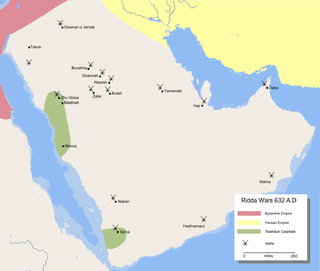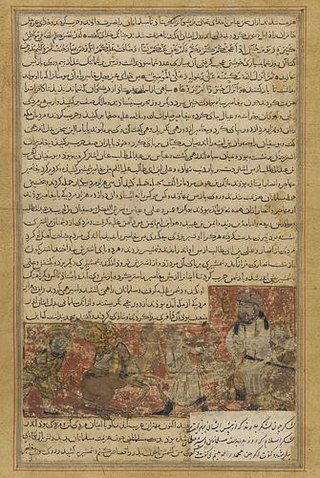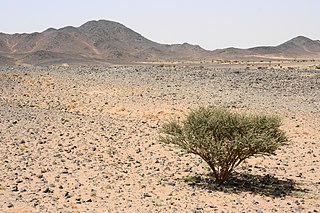| Ubla Mountain | |
|---|---|
| Highest point | |
| Coordinates | 23°39′33″N40°28′35″E / 23.65917°N 40.47639°E |
Ubla are mountains in the Medina region. [1]
| Ubla Mountain | |
|---|---|
| Highest point | |
| Coordinates | 23°39′33″N40°28′35″E / 23.65917°N 40.47639°E |
Ubla are mountains in the Medina region. [1]
Al-Bakri (1014 - 1094 AD) said: "They are mountains on the road from Mecca to Medina, in the Nakhel Valley. Ubla has a valley called Arifatan, and Ubla has many wells, including Bi'r Ma'una and Dhu Sa'ada, and Dhu Aljamajim.
At the west of the mountain are a lands of ferula it is called al-Shura, belonging to Beni Khafafaf Tribe from Beni Selim, and it has water wells on which they cultivate. It has another spring called Al-Naziya. Between the Banu Khafaf and the Ansar, they fought over it and blocked it, after many people were killed. At the east of Ubla a mountain called Dhu al-Marqa'a, which is the mineral of Bani Salim. It has a well called Al-Shaqiqaqiya, which is located at the eastern part of the city. On its right, facing the Qibla, is a mountain called Ahamer. When you bypasses the Al-Naziya spring there is a water called Hudbiyah, they are three wells, with no palms or trees, It is surrounded by villages, including Qia, three leagues apart. Also a village called Malhaa, a tribe from Haidan, which is in the valley called Qoran. It has three wells, palm trees, and trees, and around it are hills, which are said to be the hills of Dhi Majar which is a large creek between them in Qoran, with a water called Leith at the top of it. It has no farms, due to its harshness and roughness, and above it is a water called Shus. [2]
In the vicinity of this mountain is a mountain called Aqrah, which does not grow anything, and there are many tigers and sheep, then it continues through Malhaa, and ends up at a mountain called Ma’an which is belongs to the Bani Salim; next to it is Shawahat Mountain". [3]
Abu al-Qasim Mahmud bin Omar al-Zamakhshari (1074 AD -1143 AD) said: "It's name of a valley". [4]
Alhazmi al-Hamdani (1153 -1188 AD) said: "Al-Kindi said: 'Then you go from Medina up to Mecca and pass through a valley called Arifatan, which has no water or pasture. It is bordered by mountains that have water wells in them such as Bi'r Ma'una, Dhu Sa'adeh, Dhu Jamajim or Hamahim and Wasba, which belong to Bani Salim'. Al-Zuhri reported: 'Muhammad, was sent before the land of Bani Salim. On that day, he was at Bi'r Ma'una in the cliffs of Ubla'". [5]
Nasr Al-Iskandari (Died in 1166 AD) said: "As for Ubla, they are mountains at or near the Bani Salim mines". [6]
Yaqut al-Hamawi ( 1178 AD -1225 AD) said: "Aram said: 'From Medina, you go up to Mecca, and you come to a valley called Arifatan Ma'an, which has no water or pasture, and it is surrounded by mountains called Ubla. It has water wells in them such as Bi'r Ma'una, Dhu Sa'adeh, Dhu Jamajim or Hamahim and Wasba, which belong to Bani Salim'. Al-Zuhri reported: 'Muhammad, was sent before the land of Bani Salim. On that day, he was at Bi'r Ma'una in the cliffs of Ubla'". [7]
Abdulmoumen al-Baghdadi (1260 -1338 AD) said: "Mountains with water, including the well of Maouna, Dhu Sa'ada, and others that are connected to each other, for Beni Salim Tribe". [8]
Al-Samhudi said: "Aram said after mentioning al-Hajar and al-Rahdiyya: Then you proceed towards Mecca, ascending to a valley called Arifatan in the vicinity of mountains called Ubla". He then mentioned its waters and that they belonged to Bani Salim. I said It is known today between Sawarkiya and Rahdiyya, about four days from Medina. Al-Zuhri reported: "Muhammad, was sent before the land of Bani Salim. On that day, he was at Bi'r Ma'una in the cliffs of Ubla". [9]
Muhammad Hassan Sharab (1938-2013 AD) said: Al-Zuhri reported: "Muhammad, was sent before the land of Bani Salim. On that day, he was at Bi'r Ma'una in the cliffs of Ubla between Arhadia and Qoran". Al-Baladi said: "Ubla is a black mountain range located west of Al-Mahd to the north, and connected in the west to the Hejaz". [10]

Mecca is the capital of Mecca Province in the Hejaz region of western Saudi Arabia and the holiest city according to Islam. It is 70 km (43 mi) inland from Jeddah on the Red Sea, in a narrow valley 277 m (909 ft) above sea level. Its metropolitan population in 2022 was 2.4 million, making it the third-most populated city in Saudi Arabia after Riyadh and Jeddah. Around 44.5% of the population are Saudi citizens and around 55.5% are Muslim foreigners from other countries. Pilgrims more than triple the population number every year during the Ḥajj pilgrimage, observed in the twelfth Hijri month of Dhūl-Ḥijjah. With over 10.8 million international visitors in 2023, Mecca was one of the ten most visited cities in the world.

Medina, officially Al-Madinah al-Munawwarah and also commonly simplified as Madīnah or Madinah, is the capital of Medina Province in the Hejaz region of western Saudi Arabia. It is one of the oldest and most important places in Islamic history. One of the most sacred cities in Islam, the population as of 2022 is 1,411,599, making it the fourth-most populous city in the country. Around 58.5% of the population are Saudi citizens and 41.5% are foreigners. Located at the core of the Medina Province in the western reaches of the country, the city is distributed over 589 km2 (227 sq mi), of which 293 km2 (113 sq mi) constitutes the city's urban area, while the rest is occupied by the Hejaz Mountains, empty valleys, agricultural spaces and older dormant volcanoes.
Abū Hurayra ʿAbd al-Raḥmān ibn Ṣakhr al-Dawsī al-Zahrānī, commonly known as Abū Hurayra, was a companion of the Islamic prophet Muhammad and the most prolific hadith narrator in Sunni Islam.

The Ridda Wars were a series of military campaigns launched by the first caliph Abu Bakr against rebellious Arabian tribes, some of which were led by rival prophet claimants. They began shortly after the death of the Islamic prophet Muhammad in 632 and concluded the next year, with all battles won by the Rashidun Caliphate.

The conquest of Mecca was a military campaign undertaken by Muhammad and his companions during the Muslim–Quraysh War. They led the early Muslims in an advance on the Quraysh-controlled city of Mecca in December 629 or January 630. The fall of the city to Muhammad formally marked the end of the conflict between his followers and the Quraysh tribal confederation.
Al-Miqdad ibn Amr al-Bahrani, better known as al-Miqdad ibn al-Aswad al-Kindi or simply Miqdad, was one of the companions of the Islamic prophet Muhammad. His kunya was Abu Ma'bad. Miqdad was born in Eastern Arabia. He became fugitive in his hometown and ran to Mecca, where he served Aswad al-Kindi. Miqdad managed to gain favor of his master, who in turn adopted him as his son.

The Battle of Hunayn was a conflict between the Muslims of the Islamic prophet Muhammad and the tribe of Qays in the aftermath of the conquest of Mecca. The battle took place in 8 AH in the Hunayn valley on the route from Mecca to Taif. The battle ultimately ended in a decisive victory for the Muslims, and it is one of the few battles mentioned by name in the Qur'an, where it appears in Surat at-Tawbah.
The Farewell Pilgrimage refers to the one Hajj pilgrimage that Muhammad performed in the Islamic year 10 AH, following the Conquest of Mecca. Muslims believe that verse 22:27 of the Quran brought about the intent to perform Hajj in Muhammad that year. When Muhammad announced this intent, approximately 100,000 of his Sahaba gathered in Medina to perform the annual pilgrimage with him. Muhammad performed Hajj al-Qiran.
Hilf al-Fudul was an alliance or confederacy created in Mecca in the year 590 AD, to establish justice for all through collective action, especially for those who were not under the protection of any clan. Because of Muhammad's role in its formation, the alliance plays a significant role in Islamic ethics. Because fudul commonly means "virtuous" the alliance is often translated as League of the Virtuous.
The Banu Sulaym is an Arab tribe that dominated part of the Hejaz in the pre-Islamic era. They maintained close ties with the Quraysh of Mecca and the inhabitants of Medina, and fought in a number of battles against the Islamic prophet Muhammad before ultimately converting to Islam before his death in 632. They took part in the Muslim conquest of Syria, and established themselves in the Jazira, while part of the tribe remained in the Hejaz. During the early Muslim period, the tribe produced notable generals such as Safwan ibn Mu'attal, Abu'l-A'war and Umayr ibn al-Hubab. Those who remained in Arabia were largely absorbed by the Banu Harb of Yemen beginning in the 9th century, while those in Syria and the Jazira were expelled to Upper Egypt by the Fatimid Caliphs in the late 10th century for supporting the Qarmatians. In the mid-11th century, a prolonged famine in Egypt prompted the tribe to migrate westward with the Banu Hilal into Libya. There, the Sulaym and its sub-tribes established themselves mainly in Cyrenaica, where to the present day, many of the Arab tribes of that region trace their descent to the Sulaym.

The Battle of al-Harra was fought between the Umayyad army of the caliph Yazid I led by Muslim ibn Uqba and the defenders of Medina from the Ansar and Muhajirun factions, who had rebelled against the caliph. The battle took place at the lava field of Harrat Waqim in the northeastern outskirts of Medina on 26 August 683 and lasted less than a day.
The Expedition of al Raji, occurred directly after the Battle of Uhud in the year AH 4 of the Islamic calendar.
The demolition or burning of Masjid al-Dirar , or the Mosque of Dissent, is mentioned in the Qur'an. Masjid al-Dirar was a Medinian mosque that was erected close to the Quba Mosque and which the Islamic prophet Muhammad initially approved of but subsequently had destroyed while he was returning from the Expedition to Tabouk. In the main account narrated by the majority of scholars, the mosque was built by 12 hypocrites (munafiqeen) on the commands of Abu 'Amir al-Fasiq; a Hanif who refused Muhammad's invitation to Islam and instead fought along with the Meccan non-Muslims against Islam in the Battle of Uhud. Abu 'Amir reportedly urged his men to establish a stronghold and prepare whatever they can of power and weapons as he promised and insinuated to them that he will lead an army, backed by Heraclius, to fight Muhammad and his companions, and defeat his message by expelling him from Medina. Ahmad ibn Yahya al-Baladhuri also relates that the men, who built the Al-Dirar mosque "for mischief and for infidelity and to disunite the Believers" refused to pray in Quba Mosque claiming that it was built in a place where a donkey used to be tied up.

The Battle of Dhu al-Qassah took place in the area of Dhu al-Qassah, located approximately 36 kilometres (22 mi) east of Medina, in the Medina Province, in the central-western part of Saudi Arabia, from July 25 to July 30, 632. It pitted the forces of the Rashidun Caliphate led by Caliph Abu Bakr As-Siddiq against the rebel apostates led by General Hibal ibn Khuwailid,.

Al Jum'ah Mosque is a mosque in Medina, in the Hejazi region of Saudi Arabia. Also known as Masjid Banī Sālim, Masjid Al-Wādī, Masjid Al-Qubayb, and Masjid ʿĀtikah, it is said by the locals to be where the Islamic prophet Muhammad and his companions performed Salatul-Jumu'ah for the first time, during their hijrah (migration) from Mecca to Medina.

Dhū al-Shamālayn ʿUmayr ibn ʿAbd ʿAmr al-Khuzāʿī was a Meccan companion of the Islamic prophet, Muhammad, among the first Muslims known as al-Sabiqun al-Awwalun. He was a Badri martyr who sacrificed his life in the Battle of Badr al-Kubra also known as Ghazwat al-Badr or the Battle of Badr.
Shujāʿ ibn Wahb al-Asadī was a prominent companion of the Islamic prophet Muhammad in the pre-Islamic era, who participated in wars including Badr and Uhud. Some sources also suggest that Muhammad sent him as a messenger with letters to most of the world's king kings at that time. Also, a hadith narrated by Imam al-Zuhri said that Shuja was the messenger of Muhammad sent to the Persian king Khosrow II. He was the one who handed over the letter sent by Muhammad to Khosrow.
Al-Ajrad is a mountain located in the northwest of Medina, about 90 kilometers from it, to the northeast of Yanbu, about 100 kilometers from it. Buwat Valley is located below it. It is called Al-Ajrad (hairless) because it is stripped of vegetation and has few trees, which is the opposite of the Al-Ashaar (hairy), which is dotted with trees.
Wareqan Mountain is one of the Medina region mountains, it is located southwest of Medina, seventy kilometers away on the Al-Hijra highway, and is 2400 meters above sea level and is also known as the Ouf Mountains after the tribe of Bani Ouf from Harb Tribe. Wareqan Mountain was mentioned in the Islamic narrative by Muhammad when he said, "The infidel's tooth on the Day of Judgment is like Uhud, the width of his skin is seventy cubits, his neck is like Al-Bayda, his thigh is like Wareqan, and his seat in the Hellfire is like what between me and Al-Rabadha."
Rukuba is a mountain road in Saudi Arabia.